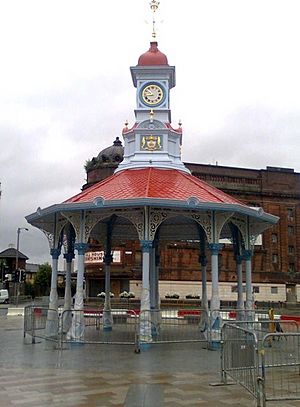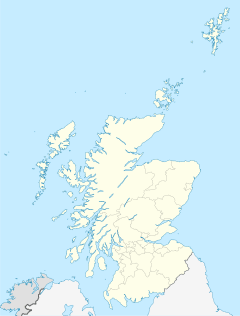Bridgeton, Glasgow facts for kids
Quick facts for kids Bridgeton
|
|
|---|---|
 Bridgeton Umbrella |
|
| OS grid reference | NS610641 |
| Council area | |
| Lieutenancy area |
|
| Country | Scotland |
| Sovereign state | United Kingdom |
| Post town | GLASGOW |
| Postcode district | G40 |
| Dialling code | 0141 |
| Ambulance | Scottish |
| EU Parliament | Scotland |
| UK Parliament |
|
| Scottish Parliament |
|
Bridgeton (also known as Scots: Brigtoun or Scottish Gaelic: Baile na Drochaid) is a busy area found just east of Glasgow city centre in Scotland. It's bordered by Glasgow Green to the west and Dalmarnock to the east and south. To the north-west is Calton, and Broad Street is to the north-east.
Contents
History of Bridgeton
Bridgeton began as a small village in 1705. It was a place where people wove cloth. Not many people were interested in living there at first.
Things changed in 1776 when Rutherglen Bridge was built. This bridge crossed the River Clyde. Because of the bridge, the area became known as Bridge Town. In Scots, this was called Brig Toun.
Bridgeton officially became part of the city of Glasgow in 1846. A big company that made carpets, James Templeton & Co, was a major employer here. Over the years, Bridgeton's boundary moved north. This happened as a nearby village called Mile-End disappeared.
Bridgeton Cross: The Heart of the Area
Bridgeton Cross is a very important meeting point. People sometimes call it 'The Toll'. It's where several main roads come together. These include London Road (A74), Dalmarnock Road (A749), Main Street, and James Street. Olympia Street and Orr Street also meet here.
The Brigton Umbrella
A special landmark at Bridgeton Cross is the "Brigton Umbrella". This is a large, old-fashioned bandstand made of cast iron. It was built in 1875 during the Victorian era. It covers the very centre of the Cross.
The Umbrella is a very important building. It has been carefully fixed up in recent years. This work also made the areas around it much nicer for people.
Transport Links
Bridgeton Cross is home to Bridgeton railway station. This station opened in 1895. It closed for a while in 1964 but reopened in 1979. It's on the Argyle Line, which connects the area to central Glasgow.
Another old station building, Bridgeton Central railway station, is nearby. It operated from 1892 to 1979. Many local buses also travel along London Road and Dalmarnock Road.
Local Landmarks
The Olympia Theatre was built in 1911 at the Cross. It was empty for many years. But it was rebuilt and reopened in 2012. Now, it's a modern library and community centre for everyone in Bridgeton.
There are also several pubs in the area. Many of them are decorated with themes related to Rangers F.C..
Millers 1893 is a very old family business. William Millard started it in 1893. They sold linoleum. The business is still running today. It's believed to be the only family business from the 1800s still operating in the area.
Points of Interest
Bridgeton has one of Glasgow's original Carnegie libraries. These libraries were built with money from a famous businessman, Andrew Carnegie. This library was designed by architect James Robert Rhind.
Since 2014, the library has been used by the Glasgow Women's Library. They have a lending library, an archive, and a museum collection. They have also made many improvements to the building.
Sporting Facilities
After Glasgow hosted the 2014 Commonwealth Games, Bridgeton gained great sports facilities. The Commonwealth Arena and Sir Chris Hoy Velodrome are very close by in Dalmarnock.
The Crownpoint Sports Complex is also in the area. It's a modern outdoor athletics track. It's right next to St Mungo's Academy.
Cultural Parades
Bridgeton is an important centre for the Orange Order in Scotland. Their parades are a common sight in Glasgow during the summer. These parades are especially noticeable around the Twelfth of July. They remember the Battle of the Boyne.
Vehicle Preservation
The Glasgow Vintage Vehicle Trust is based at Bridgeton Bus Garage. This group works to save and look after old buses and other vehicles. It's one of the biggest groups of its kind in Scotland.
The bus garage opened in 1965. It was used as a bus garage for a short time. Then, it was used by the council to service their vehicles. Now, it's rented out for vehicle preservation.
Bridgeton Burns Club
In 1870, a grocer named John Wilson and his friends started the Bridgeton Burns Club. This club is a charity. It still helps local children today.
Football in Bridgeton
For about 40 years in the mid-1900s, Bridgeton had its own football team. This team was called Bridgeton Waverley F.C.. They played in the Scottish Junior Football Association.
They first played at Shawfield Stadium. Later, they moved to Barrowfield Park. This park was bought and removed to build new homes. Waverley then moved to New Barrowfield. After the team stopped playing in the 1960s, this site became the training ground for Celtic F.C..
Another local team, Strathclyde F.C., also stopped playing around the same time. Older teams like Thistle F.C., Clyde F.C., and Eastern F.C. also had links to Bridgeton.
Even though Celtic's stadium is nearby, the area is now known for its strong support for Rangers F.C..
Notable people
- Elky Clark, boxer
- Jim Diamond, singer and musician
- Lonnie Donegan, skiffle musician
- Bobby Dougan, footballer
- Don Greenlees, footballer
- David Hayman, actor
- Lorraine Kelly, TV presenter
- Archie Kyle, footballer
- Hugh MacDonald, journalist
- Billy Mack, actor
- Henry May, recipient of the Victoria Cross
- Frankie Miller, rock musician
- Willie Miller MBE, footballer
- William Sheret, showjumper
- Jim Watt, boxer
- John Paul Young, singer




